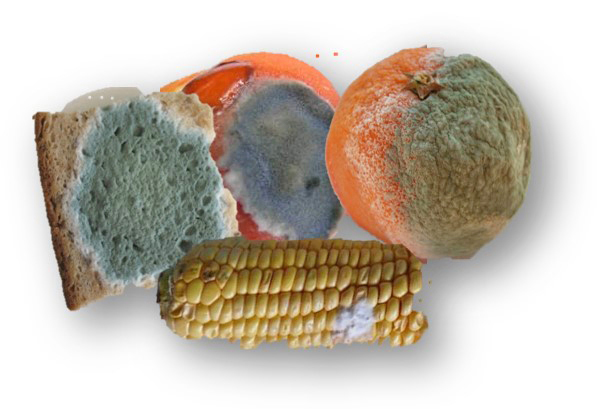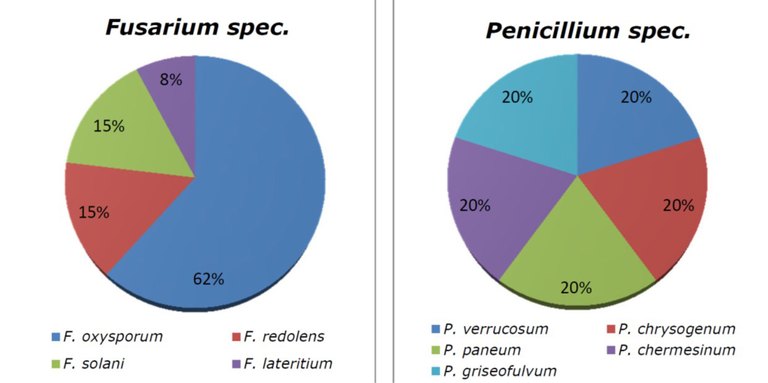Plant food safety assessment tools
Filamentous fungi are a fundamental component of the biosphere. As the second-largest group of organisms in the terrestrial biosphere in terms of numbers, directly after plants, fungi are responsible for a large number of important material transformation processes. Among other things, they break down organic material and thus make nutrients available to other living organisms.
Fungi occur both as spoilage organisms, human pathogens, plant pathogens, and also as producers of pharmacologically and toxicologically relevant metabolites such as antibiotics and mycotoxins in a wide variety of habitats on the planet: in and on the human and animal body, in and on the earth's substrate, the air, and also in and on plants. Primarily, fungi as pathogens attack already pre-damaged plants or overripe fruits, where they lead to spoilage and the formation of toxic metabolites.
The investigation of the fungal populations present on a foodstuff (mycobiome) is an important tool for the mycological research work of the Department of Safety and Quality of Fruit and Vegetables. The workflow shown in Figure 1 illustrates a typical mycobiome analysis. In most cases, an infested food is used as a starting point for the analyses. First, fungal spores are separated from the sample material and pure cultures are obtained. Then the genetic material, i.e. the genomic DNA, is isolated from the fungi. Within the genetic information, certain regions are then sequenced (genotyping) that are very specific to a particular fungal genus and species. These can be the so-called ITS sequence (Internal transcribed spacer), the ribosomal RNA (18S; 28S; 5S 5,8S), or so-called "housekeeping genes". The sequences obtained are then compared with special databases to identify the fungal species. Classical microbiological analyses and microscopic examinations are also used for validation (phenotyping).
If research is also to be conducted into which fungal toxins (mycotoxins) or other toxicologically relevant metabolites the identified fungal species can produce, so-called fingerprint chemotyping is carried out. For this purpose, the metabolites formed by the fungus are extracted from the mycelium with solvents and this extract is separated by thin-layer chromatography (chemotyping). The separated metabolites are then compared with reference standards and previous chemotyping of already known fungal species. However, in order to properly determine the genetic capacity of a fungus to produce specific metabolites, its complete genome must be known. Compared to bacteria, fungi as eukaryotes have a much larger and more complex genome. Analyses of eukaryotic genomes are therefore bioinformatically very complex. Within the genome of fungi occurring on different foods, the Department of Safety and Quality of Fruit and Vegetables investigates, identifies and characterizes so-called biosynthetic gene cluster signatures. This makes it easy to distinguish between fungi of the same species but which produce different metabolites, to assess their safety risk and also to make a statement about their phylogenetic development. This is because mycotoxin gene clusters are sometimes exchanged between different fungal species. This process is called Horizontal Gene Transfer (HGT). Then a fungus that was not actually known to do so suddenly becomes a mycotoxin-producing fungus. However, such events occur (fortunately) comparatively rarely and only under strong evolutionary pressure. If the genetic makeup of a fungus is now known, molecular detection methods can be developed using so-called key genes, and the activity of mycotoxin genes can be studied under different storage conditions. Insights into the molecular mechanisms underlying fungal-plant interactions are of elementary importance for safeguarding our future nutrition and are being investigated at the Department of Safety and Quality of Fruit and Vegetables within the framework of various research projects (e.g. ZwieÖl, AflaZ and Alternaria-UBMAL). From the knowledge gained in this way, general recommendations for action are derived for policy-makers and consumers, and sustainable, efficient strategies against fungal infestation and mycotoxin formation on crops are developed.



